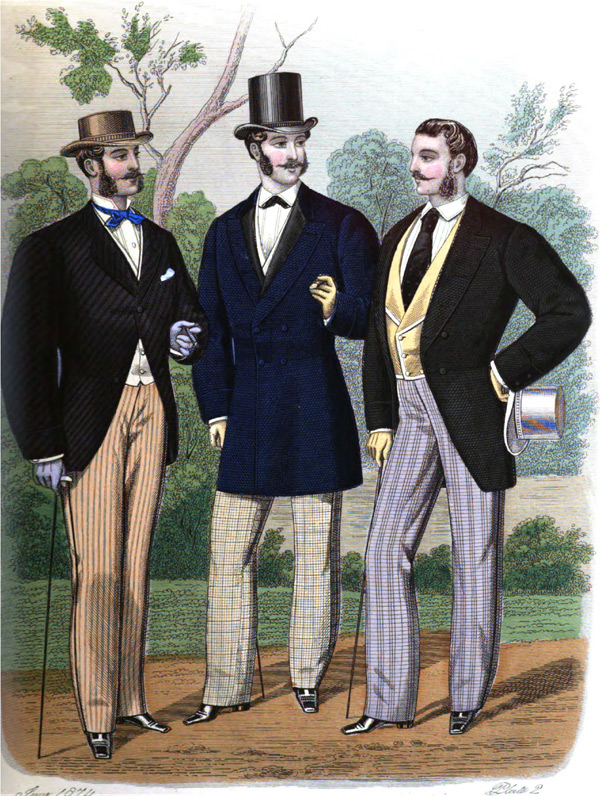Prices and Availability Subject to Change. Please call 800-997-4311 for more Information.
1820s Men's Clothing Guide
By 1821, when the Prince Regent became King George IV, the neoclassical aesthetic which was so in vogue at the beginning of the 19th century, was being replaced by a fascination with medieval gothic. Writers such as Byron, Keats and Scott had produced works in the previous decade motivated by ideals of authentic expression of personal imagination and emotion, with a reverence for nature and a nostalgia for the past - in sharp contrast to the Industrial Revolution they were living through.
Men's fashion, which for two decades had been modest and restrained in both cut and color, let loose with a more dramatic silhouette. The waistline dropped from its "empire line" height to a more natural waist placement for both men and women and became much more defined, requiring the addition of the waist seam to coats for shaping. The desirable torso shape became much more rounded, with padding placed at the shoulder and in the front of the coat to give a puffed, pigeon chested silhouette. The fashionable skin tight pantaloons even meant that padded stockings might be worn to give the requisite muscled effect, which, coupled with the wearing of corsets by those extreme dandies in pursuit of the perfect body shape led to much derision at the hands of the era's satirical cartoonists.
Despite the exaggerated look of the fashions of the decade, by the end of 1820s we can see the emergence of the frock coat and trousers, setting the scene for menswear for the decades to come.
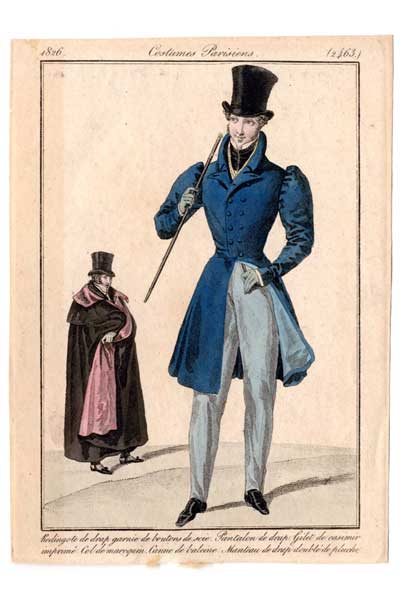
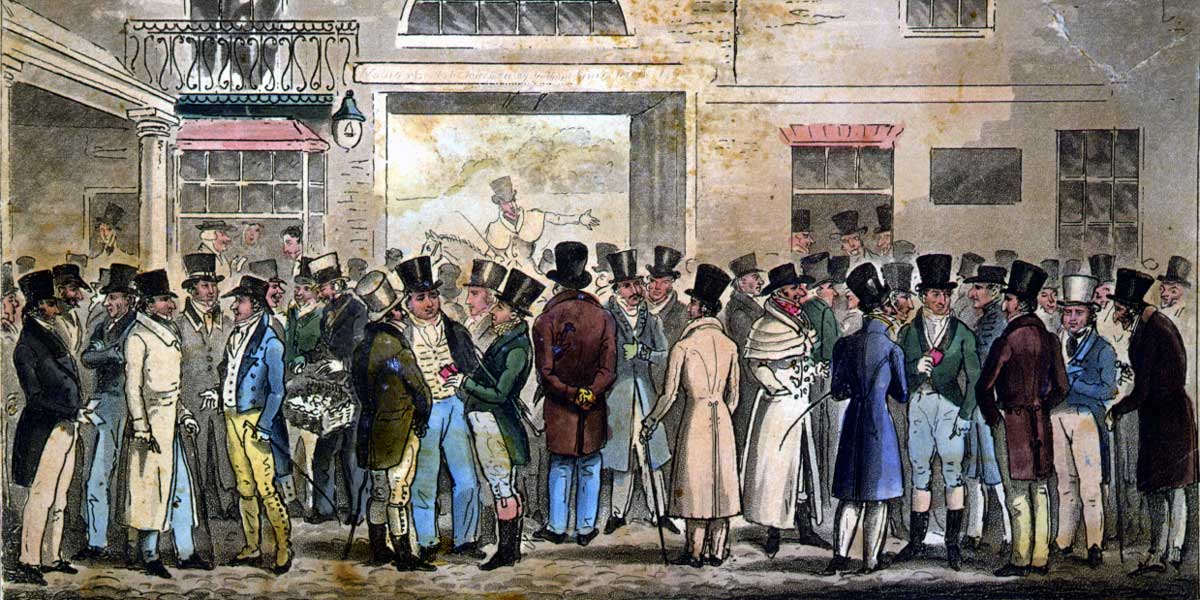
Coats
In the 1820s men continued to wear the tailcoat for formal occasions by day and in the evening. This style had originated from English country coats in the late 18th century, with the front part of the coat cut away at the waistline to allow gentlemen to ride more easily, but was now the standard in men's dress. Made of fine wool, tailcoats in this period were more often double breasted, cut straight across the waist and worn tightly fastened, now featuring a waist seam where the tails were cut separately for a more fitted waistline. The collar was very tall and rounded, and both collar and lapels stiffened heavily and even padded along with the shoulders, upper chest and hips, to further accentuate a small waistline. Sleeves became puffed at the armhole, echoing women's fashions and adding to the theatricality. Usually made in darker colors as in previous decades, they were also seen in lighter buffs and even sky blue, as worn by King George himself.
The riding coat (also called Newmarket coat or morning coat), was a slightly less formal variation of the tailcoat for day wear, which sloped gently from opening to tails instead of cutting away sharply at the waist.
The new and fashionable coat of the decade however, was the frock coat, which had appeared in the 1810s. This coat was military inspired, with full, knee-length skirts and a fitted waist, and originally with braid trim and buttoning up to a tall stand collar. In the 1820s it was given the same upper body shape as the tailcoat, and with its tight waistline and full swishing skirts and became a popular choice for informal day wear among fashionable young men.
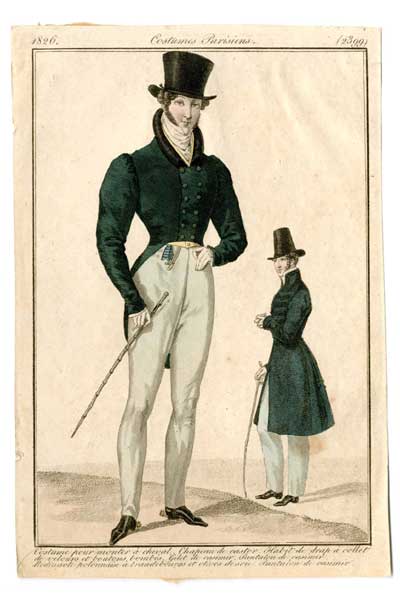
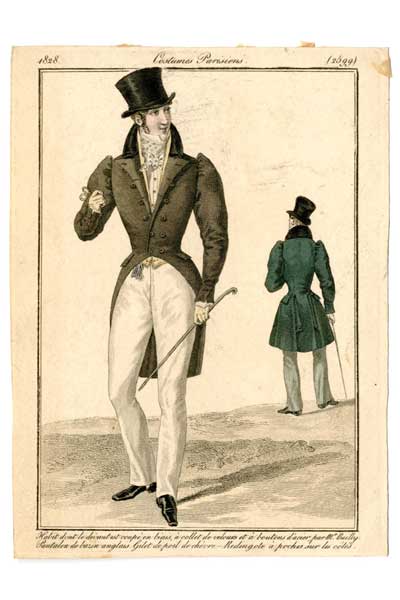
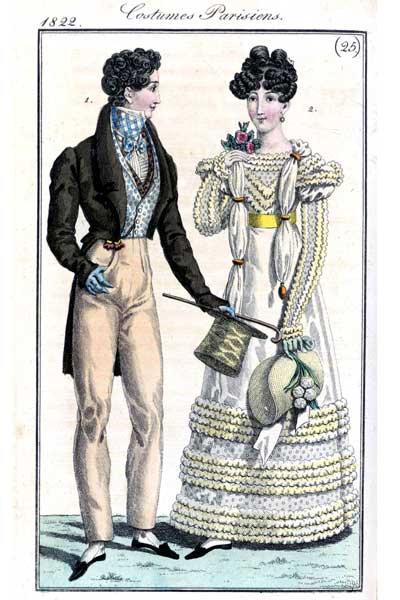
Vests
Vests, called waistcoats, were always required, and although less on show than in previous decades they still peeked out above and below the buttoned tailcoat. Single or double breasted, the hem now more frequently sloped down to points at the center front, rather than being cut straight across. Towards the end of the decade the neckline changed from the tall stiff collar and lapels to a lower, rounded shawl collar which would be fashionable in the 1830s, with a long opening to display the multitude of frills or pleats on the shirt front.
Waistcoats for the daytime could be a solid color or patterned, often lighter in color than the coat. It was also not uncommon to wear more than one waistcoat at once, in pursuit of the fashionable puff-chested silhouette. Black or white waistcoats were in vogue for evening wear.
Shirts
Shirts were styled similarly to the 1810s. Made primarily of cotton or linen. The fashion was for plain white, with very tall collars sitting under the chin, and tucks and pleats down the front opening, with frills and ruffles for evening wear. Despite that there are always those who express their individuality, in this case with a brightly striped shirt.
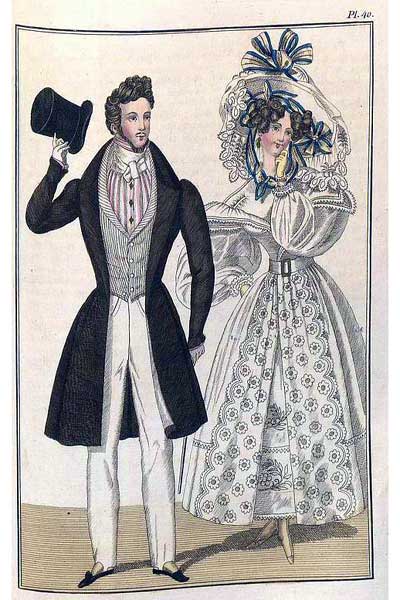
Ties
The cravat, a large square of starched muslin or silk was still in vogue in the 1820s, but now seen in patterns and colors for casual wear ("undress"), with a black silk or satin cravat inspired by military dress becoming the most popular form for all daytime events at the end of the decade. This could be folded into a multitude of styles, with origami-like instructions; the details of which knot was chosen by whom and for what occasion being the subject of many guidebooks.
Stocks, also originating in military costume, were an alternative to a cravat in the 1820s, having been made fashionable by the new king George IV. A shaped band of horsehair, buckram or whalebone bound with leather, and fastened at the back with ties or a buckle, they were covered in fabric, sometimes plain, sometimes with a bow tied on top. The 'Royal George' was a black silk velvet stock, and black silk stocks continued to be worn into the 1840s.
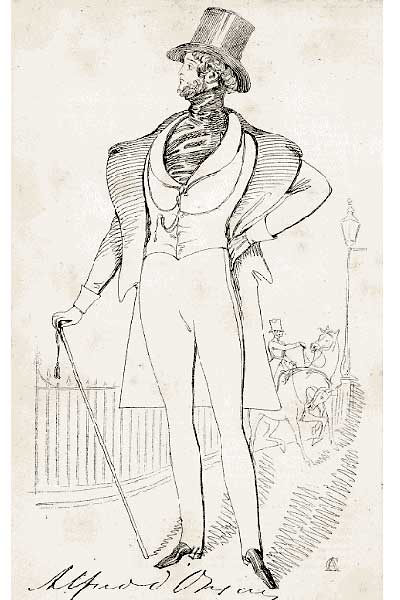
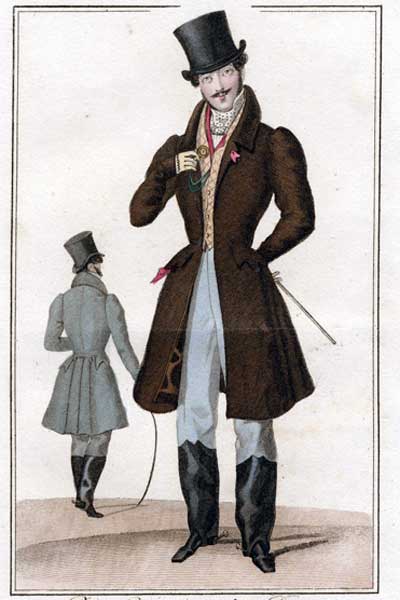
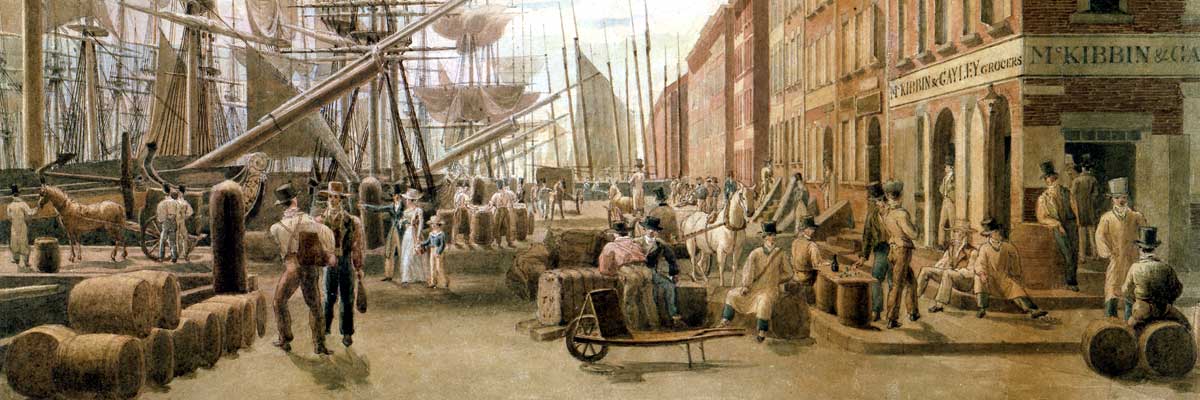
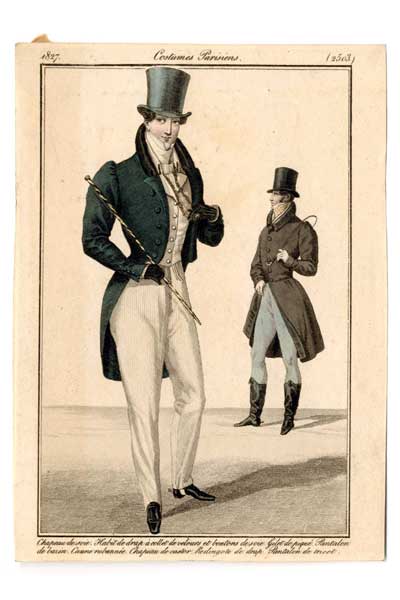
Pants
By the 1820s, breeches were rarely worn in the day except for riding, or for the royal court which still favored 18th century styles. Pantaloons, form-skimming, ankle length and fastened by a number of small buttons at the hem, were increasingly becoming evening wear, worn in black or cream.
For daytime, even the martial glamour of the tight fitting pantaloons were being increasingly replaced by slim trousers. These new trousers were usually cut straight over the hips, but in the 1820s the Cossack style, full and pleated into the waistband, was also popular, having been inspired by Russian Cossack cavalry regiment of the Napoleonic wars a decade earlier. Both styles could be secured by an instep strap worn under the shoes, or tucked into a boot, to maintain an elegant line. For evening wear, pantaloons in cream or black were the fashionable choice until well into the 1830s.
Rather than the single opening of modern day, all Regency pants had a flap panel 5-8 inches wide called a fall that opened in the front and fastened with buttons. The single button fly was increasingly seen on trousers through the 1830s however, and became standard issue by 1840. All pants were worn with suspenders, belts not becoming commonplace until the 20th century.
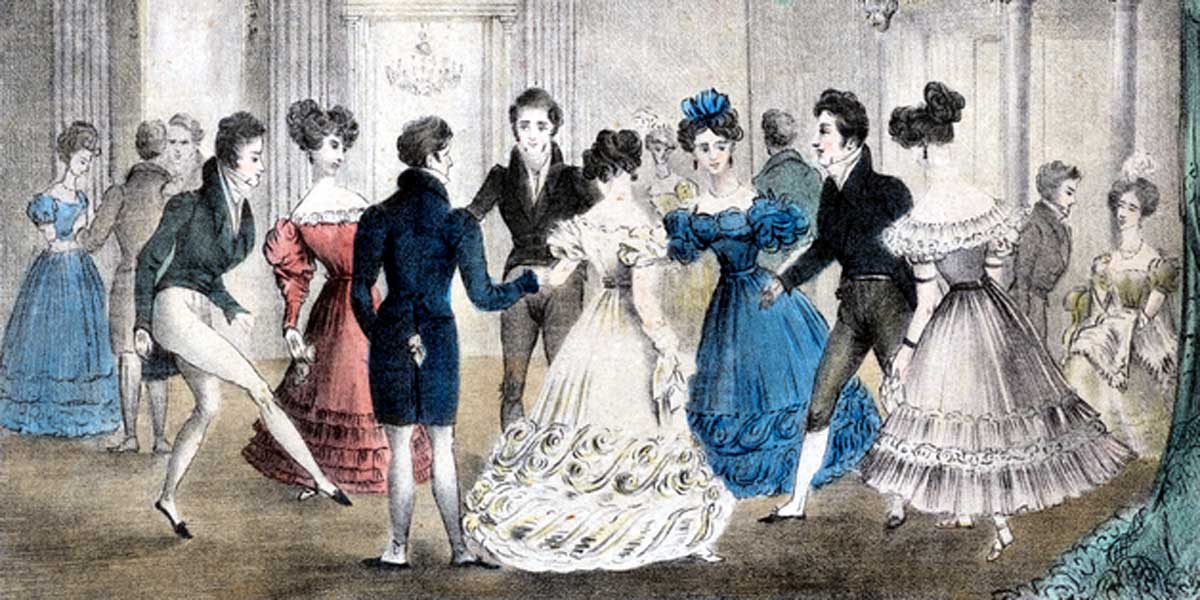
Evening Wear
Evening wear of this period consisted of a dark-colored tailcoat, worn over a dark or cream waistcoat and white shirt with a frilled front, with a white cravat or stock. Black or cream pantaloons were worn with silk stocking and black leather dress pumps, fastened with ribbons tied into neat bows.
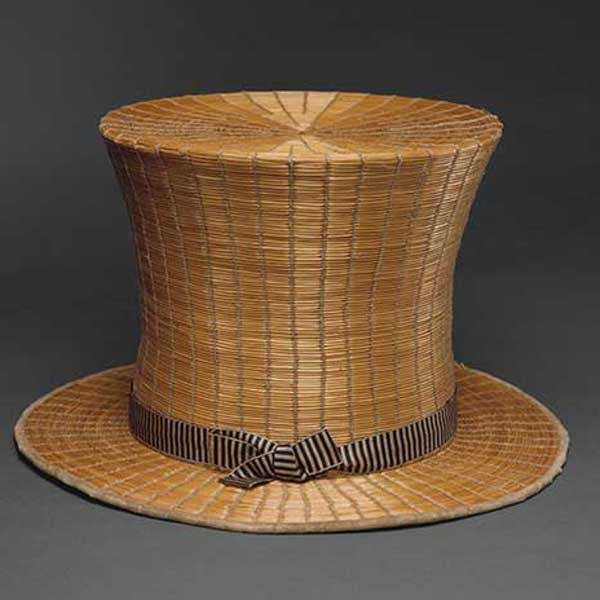
Hats
By 1820, the cocked tricorne and bicorne hats had disappeared from gentlemen's dress and the top hat was the most commonly worn style; although still seen in a wide variety of shapes, made from wool felt, beaver pelt or even raffia (a durable type of palm leaf used to construct hats).
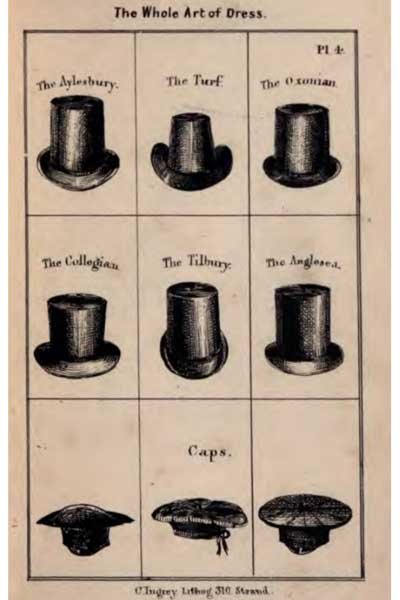
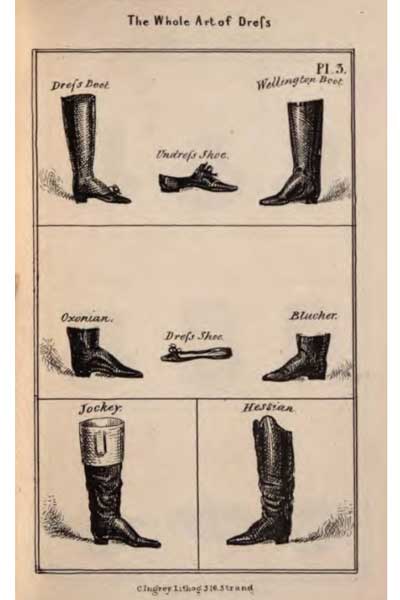
Footwear
Boots were still popular in the 1820s, whether the Hessian boot, knee height with a decorative tassel, or the square-toed and lower-cut Wellington, named for the British duke and general. Boots could now also be worn underneath the new wider trousers. There were also black leather pumps for daytime, and more elegant pumps for evening, fastened with ribbons.
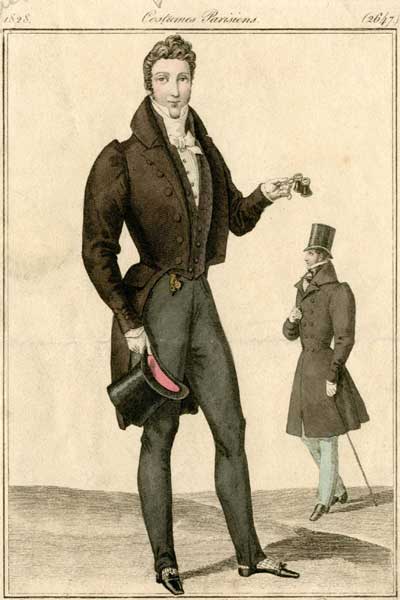
Hair & Accessories
Men's hairstyles continued to be cut short and left natural. Men were most often clean shaven, with short sideburns at most. A gentleman would also wear a watch, tucked into a pocket in the breeches. Fobs are seen below the waistcoat in many fashion plates; a short length of moire ribbon connecting two gold bars which connected to the watch, with seals hanging from below it.
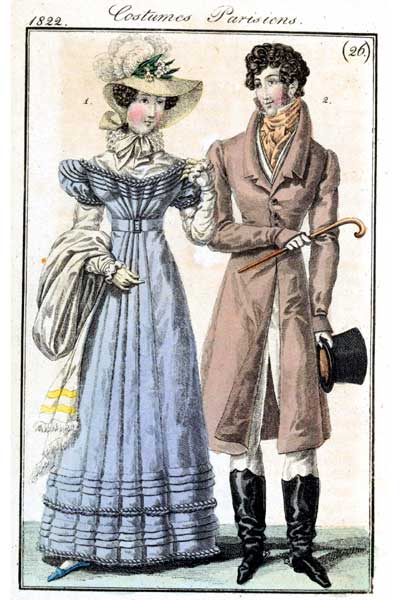
Q&A About 1820s Men's Fashion
What did men wear in the 1820s?
What did upper class men wear in the 1820s?
What did lower class men wear in the 1820s?

Complete Regency Outfits
We offer a full line of men's period clothing which are suitable for movie and TV production, theatrical, living history and performing arts requirements, and are also perfect for vintage weddings!
All of the products we sell are sold individually, but we have put together these full outfits to showcase the elements of Regency style for your consideration and inspiration.
Click any image for a close-up and a list of the products shown.

